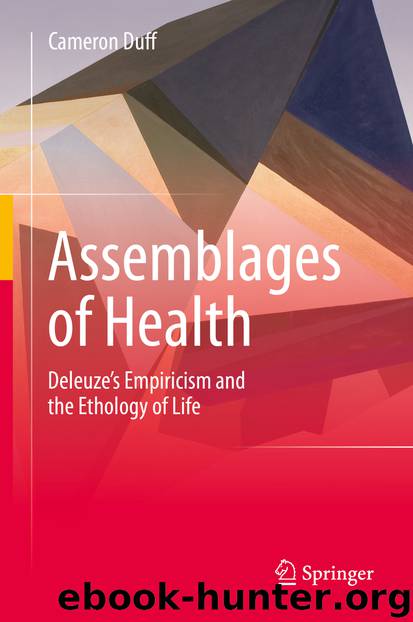Assemblages of Health by Cameron Duff

Author:Cameron Duff
Language: eng
Format: epub
Publisher: Springer Netherlands, Dordrecht
4.2.1 The Social Assemblage
It may be argued that social inclusion and community participation facilitate recovery from mental health problems to the extent that each promotes access to an array of social, material and affective resources which may then be utilised in the everyday work of recovery (see Duff 2010, 2012 for a review). Drawing on the ‘empirico-ethological’ account of health described in Chaps. 2 and 3, social resources may be understood to describe the varied processes and encounters – the relational, affective and embodied ‘signs’ and ‘events’ – which support the creation and maintenance of social networks in collocations of the human and the nonhuman. Social resources thus describe the means or processes by which social ties are cultivated and maintained. The real problem however, is to explain sociality itself in terms of the discrete resources that permit the realisation of specifically social relations. Such a concern speaks once more to the need to identify the ‘conditions of real experience’ immanent to the production of sociality, and its subsequent expression in the course of recovery from mental illness. In the absence of such analysis, sociality risks being ‘naturalised’ as innately healthy or therapeutic, leaving unresolved the question of how social interaction is mediated in a social field, and how sociality actually supports recovery. Suggestive indications of the links between sociality and recovery may be drawn from the literature on social capital, even though this literature rarely addresses the conditions of sociality itself (Duff 2011).
As it is conventionally understood, social capital comprises the myriad bonds of trust, reciprocity and cooperation that characterise social life (see Portes 1998). The model attempts to conceptualise the impact of social networks through the study of the social, affective and material resources on which they draw. Such resources have been shown to enable and extend the array of ‘coordinated actions’ realisable within particular networks (Hawe and Shiell 2000). While the specific resources individuals actually derive from their networks are always diverse, one’s overall stock of social capital is fundamentally linked to the size, number and diversity of one’s network connections, and the ways one can leverage these ties through the use of other forms of financial, intellectual, cultural and/or symbolic capital. Like these other forms, social capital ‘flows’ through networks in a series of formal and informal transactions. As such, social capital may be regarded as a fluid and potentially transferable resource useful for the realization of various goals or actions, including specific health related goals (Almedom 2005). Examples of social capital range from informational resources including job referrals, health care tips, and relationship counselling, through to the social transmission of material resources such as loans, ‘gifts’, bartering and other non-market based forms of exchange. What the extant literature on social capital largely lacks, however, is a compelling account of the character of sociality, and the mechanisms involved in the cultivation of social ties.
In other words, the notion of social capital may well describe the varied benefits that individuals and groups derive from their social networks
Download
This site does not store any files on its server. We only index and link to content provided by other sites. Please contact the content providers to delete copyright contents if any and email us, we'll remove relevant links or contents immediately.
| Administration & Medicine Economics | Allied Health Professions |
| Basic Sciences | Dentistry |
| History | Medical Informatics |
| Medicine | Nursing |
| Pharmacology | Psychology |
| Research | Veterinary Medicine |
Good by S. Walden(3347)
The Social Psychology of Inequality by Unknown(2766)
The Checklist Manifesto by Atul Gawande(2657)
0041152001443424520 .pdf by Unknown(2595)
The Meaning of the Library by unknow(2385)
Guns, Germs and Steel by Diamond Jared(2197)
23:27 by H. L. Roberts(2142)
Borders by unknow(2117)
Being Mortal: Medicine and What Matters in the End by Atul Gawande(2037)
And the Band Played On by Randy Shilts(2014)
A Leg to Stand On by Oliver Sacks(1934)
The Hot Zone by Richard Preston(1910)
The Valachi Papers by Peter Maas(1762)
The Laws of Medicine by Siddhartha Mukherjee(1689)
The Andromeda Strain by Michael Crichton(1631)
The Obesity Epidemic by Robyn Toomath(1603)
Get What's Yours for Medicare: Maximize Your Coverage, Minimize Your Costs by Philip Moeller(1553)
Pharmacy Practice and The Law by Richard Abood(1493)
The Plague and I by Betty Macdonald(1451)
